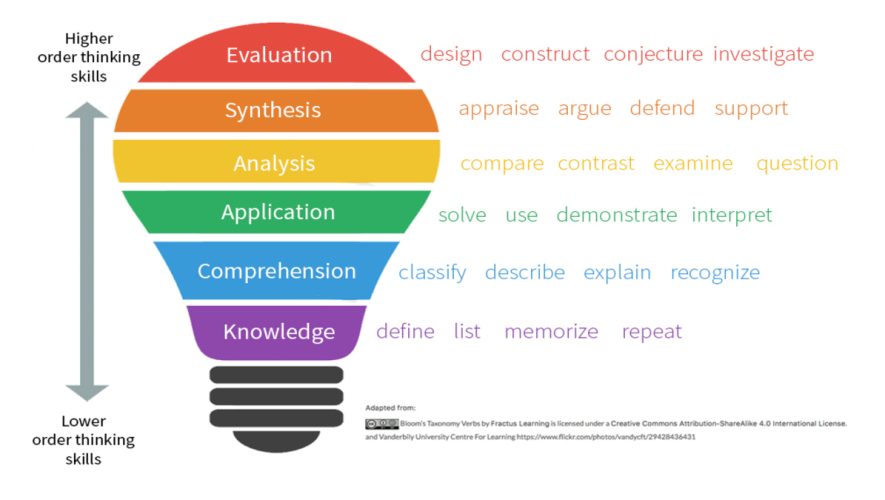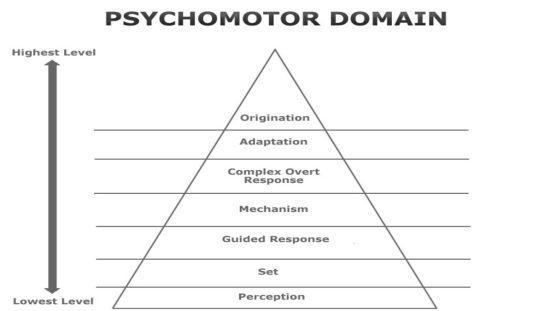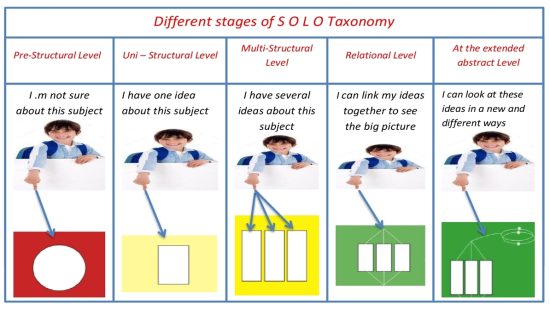The cognitive domain involves knowledge and the development of intellectual skills (Bloom et.al, 1956). This includes the recall or recognition of specific facts, procedural patterns, and concepts that serve in the development of intellectual abilities and skills. The framework elaborated by Bloom and his collaborators consisted of six major categories: Knowledge, Comprehension, Application, Analysis, Synthesis, and Evaluation. These categories are starting from the simplest behavior to the most complex. The categories can be thought of as degrees of difficulties. That is, the first ones must normally be mastered before the next ones can take place.
Some users of the Bloom’s taxonomy place more emphasis on the hierarchical nature of the framework, asserting that the first three elements—Knowledge, Comprehension, and Application—represent lower-order thinking skills (LOTS), while Analysis, Synthesis, and Evaluation are considered higher-order thinking skills (HOTS). For this reason, the taxonomy is often graphically represented as a pyramid with higher-order cognition at the top.
Levels of Cognitive Domain of Learning
Here are the authors’ brief explanations of these main categories in from the appendix of Taxonomy of Educational Objectives (Handbook One, pp. 201-207):
1. Knowledge
Knowledge “involves the recall of specifics and universals, the recall of methods and processes, or the recall of a pattern, structure, or setting.”
Key Words (Verbs) — Defines, States, Describes, Identifies, Knows, Labels, Enlists, Matches, Names, Outlines, Recalls, Tells, Recognizes, Reproduces, Selects, Arranges, Quotes, Repeat, and Enumerates.
Examples (Learning Objectives) — The student will be able to; Define a term. Recite few verses from the text. Label different parts of diagram.
2. Comprehension
Comprehension “refers to a type of understanding or apprehension such that the individual knows what is being communicated and can make use of the material or idea being communicated without necessarily relating it to other material or seeing its fullest implications.”
Key Words (Verbs) — Comprehends, Converts, Describes, Distinguishes, Estimates, Explains, Extends, Generalizes, Gives an example, Infers, Interprets, Paraphrases, Predicts, Rewrites, Summarizes, and Translates.
Examples (Learning Objectives) — The student will be able to; Give an example of a scientific fact from daily life. Explain a concept or piece of knowledge. Generalize the results of a specific situation.
3. Application
Application refers to the “use of abstractions in particular and concrete situations.”
Key Words (Verbs) — Applies, Adapt, Ascertain, Assign, Changes, Computes, Constructs, Demonstrates, Discovers, Manipulates, Modifies, Operates, Predicts, Prepares, Produces, Relates, Shows, Solves, and Uses.
Examples (Learning Objectives) — The student will be able to; Uses a formula to solve given set of values. Apply concepts and principles to new situations. Demonstrate correct usage of grammar rules to form sentences.
4. Analysis
Analysis represents the “breakdown of a communication into its constituent elements or parts such that the relative hierarchy of ideas is made clear and/or the relations between ideas expressed are made explicit.”
Key Words (Verbs) — Analyzes, Breaks down, Compares, Contrasts, Draws, Deconstructs, Differentiates, Discriminates, Distinguishes, Identifies, Illustrates, Infers, Outlines, Relates, Diagrams, Selects, and Separates.
Examples (Learning Objectives) — The student will be able to; Identify the required parts of speech from a given paragraph. Compare and contrast the two presidential speeches in writing. Analyzing the organizational structure of a work (of art, music, or writing).
5. Synthesis
Synthesis involves the “putting together of elements and parts so as to form a whole.”
Key Words (Verbs) — Categorizes, Combines, Compiles, Composes, Creates, Devises, Designs, Explains, Generates, Modifies, Organizes, Plans, Rearranges, Reconstructs, Relates, Reorganizes, Revises, Rewrites, Summarizes, and Writes.
Examples (Learning Objectives) — The student will be able to; Write a creative essay, story or poem on the given topic. Develop a plan for your school to save money. Formulating a new scheme for classifying objects.
6. Evaluation
Evaluation engenders “judgments about the value of material and methods for given purposes.”
Key Words (Verbs) — Judges, Comments, Appraises, Compares, Concludes, Contrasts, Criticizes, Critiques, Defends, Describes, Discriminates, Evaluates, Explains, Interprets, Justifies, Relates, Supports, and Summarizes.
Examples (Learning Objectives) — The student will be able to; Critically appreciate the given piece of literature. Decide which proposed plan is the best. Justify the actions of your favorite historical figure.
Reference
Bloom, B.S. (Ed.). Engelhart, M.D., Furst, E.J., Hill, W.H., Krathwohl, D.R. (1956). Taxonomy of Educational Objectives, Handbook I: The Cognitive Domain. New York: David McKay Co Inc.
OTHER RELATED POSTS
Bloom’s Taxonomy of Educational Objectives
SOLO Taxonomy versus Bloom’s Taxonomy




Thank you so much💞💞💞
This is so helpful❤️